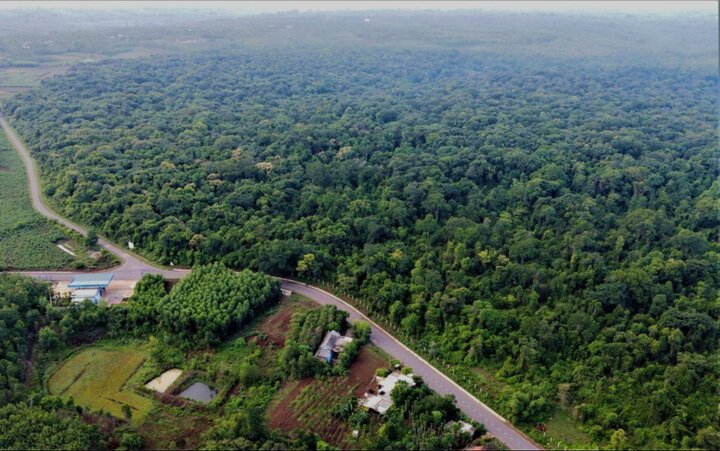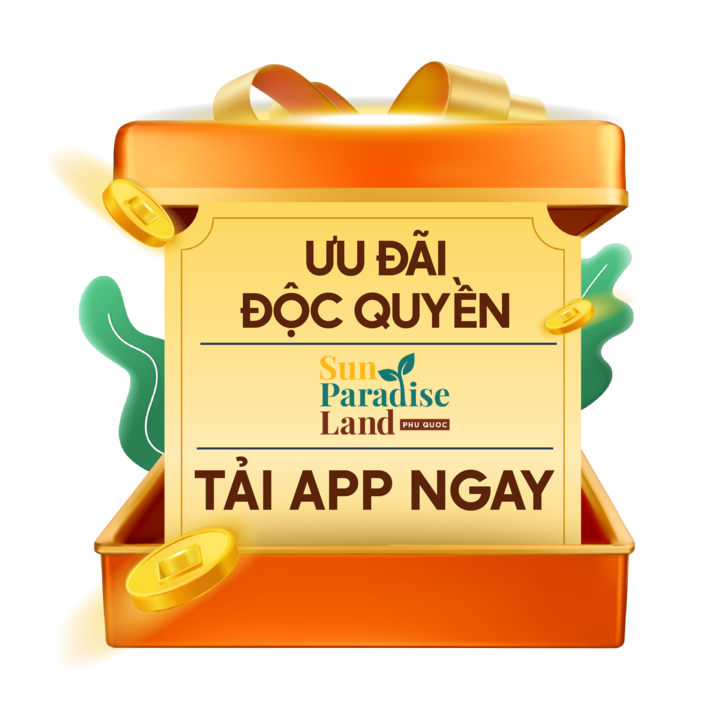1. Introduction to Phu Quoc National
1.1 Location and Overview
Phu Quoc National Park is located in the northeastern part of Phu Quoc Island, under the jurisdiction of Kien Giang Province. This natural reserve spans an area of approximately 31,422 hectares, covering more than 70% of the island’s total surface. The park features a rich mosaic of primeval forest zones, rolling hills, rivers, streams, and coastal marine areas—creating an exceptionally diverse ecosystem rarely found elsewhere.
Phu Quoc National Park is often referred to as the “green lung” of Pearl Island. (Photo: Collected)
Administratively, the park covers Bai Thom, Cua Can, and Ganh Dau communes, as well as parts of Ham Ninh and Cua Duong communes. Established in 2001 by decision of the Prime Minister, the park plays a vital role in biodiversity conservation and serves as an attractive destination for eco-tourism.
Highlights:
Elevation: The highest peak is Mount Chua (603 meters), ideal for trekking adventures.
Ecosystem: Home to tropical rainforest with rich vegetation and rare wildlife species.
Climate: Mild and cool year-round, with two distinct seasons: dry season (November–April) and rainy season (May–October). Summers at the park are pleasantly cool and refreshing.
1.2 How to Get to Phu Quoc National Park
No matter where you are on the island, it’s convenient to reach Phu Quoc National Park. First, head to Duong Dong Town – the island’s administrative and tourism hub – then follow the directions below:
Popular Routes:
From Duong Dong: Take Nguyen Trung Truc Street toward Bai Thom commune. At the Duong Dong – Bai Thom junction, turn right and continue for about 6 km to reach the park entrance.
From Phu Quoc Airport: Head northeast via route DT45 for approximately 35 km.
Transportation Options: You can rent a motorbike (about 150,000–200,000 VND/day) or a self-drive car (around 700,000 VND/day).
Tips:
After reaching the entrance, you’ll need to park and walk about 8 km to delve into the core rainforest.
Hiring a local guide is highly recommended to ensure safety and avoid getting lost in the forest.
Best time to visit: From November to April (dry season) when the weather is cool, dry, and perfect for trekking. During the rainy season (May to October), the park becomes lush and green, though trails can be slippery. However, this is also when streams like Tranh and Da Ban are at their fullest, offering stunning scenery.
Breathtaking natural beauty at Phu Quoc’s streams (Photo: Collected)
2. What Makes Phu Quoc National Park So Special?
A trip to Phu Quoc National Park offers travelers the chance to explore one of Vietnam’s richest and most diverse ecosystems. Here, you can admire breathtaking natural landscapes and engage in a variety of exciting eco-tourism activities.
2.1 A Diverse and Pristine Flora & Fauna
Rich biodiversity in Phu Quoc’s rainforest (Photo: Collected)
Phu Quoc National Park is home to a tropical rainforest ecosystem, featuring:
Flora: Over 1,164 plant species, including valuable hardwoods such as dầu cát (Shorea spp.), vên vên, red chestnut, and yellow melaleuca. You’ll also find rare orchids like lady’s slipper orchids, jewel orchids, and precious medicinal herbs like polygonum, licorice, and wild chrysanthemum.
Fauna: About 30 mammal species, 200 bird species, and 50 reptile species inhabit the park. Some endangered species listed in Vietnam’s Red Book include the Pileated gibbon, forest wolf, and great hornbill.
Marine ecosystem: Offshore areas are home to around 20 species of soft corals, 100 species of hard corals, 62 types of seaweed, and a wide variety of colorful fish.
What makes the park even more unique is the natural interweaving of forest, mountains, streams, and sea—giving visitors a chance to explore the island’s untouched beauty from every angle.
2.2 Admire the Blooming Sim and Camellia Flowers
Sim flowers in full bloom at Phu Quoc National Park (Photo: Collected)
From March to June, during the spring months, Phu Quoc National Park is adorned with vibrant blooms of local wildflowers. Hillsides are blanketed with blooming sim (rose myrtle) flowers, creating dreamy purple landscapes perfect for photo ops. Camellia flowers, with their striking red hue, often grow along stream banks, adding brilliant touches of color to the lush green backdrop. This is an ideal time for a scenic stroll surrounded by birdsong and the gentle fragrance of the forest.
2.3 Trekking to Mount Chua – “The Rooftop of Phu Quoc”
If you’re into adventure and exploration, conquering Mount Chua is a must.
Elevation: 603 meters – the highest point on Phu Quoc Island.
Trek Duration: Around 4–5 hours through pristine rainforest, along leaf-covered trails, crossing small streams and steep slopes.
Trekking is a favorite activity in the national park (Photo: Collected)
Trekking Highlights:
Encounter diverse flora and fauna in the old-growth forest and feel the thrill of conquering nature’s grandeur—ideal for adventure seekers and nature lovers.
Check in at the summit for a panoramic 360-degree view of Pearl Island, from vast green forests to the shimmering ocean beyond.
2.4 Relax and Bathe in the Park’s Refreshing Streams
Phu Quoc National Park is known for its clean and cool mountain streams originating from the Ham Ninh Range. Here are some must-visit streams:
Tranh Stream: A popular spot for swimming and picnicking, with gentle waterfalls and green lawns.
Da Ban Stream: Known for its cool water and large flat rocks—perfect for resting.
Da Ngon Stream: More remote and wild, featuring higher waterfalls, ideal for camping and freshwater bathing.
3. Essential Travel Tips for Visiting Phu Quoc National Park
Phu Quoc National Park is an ideal destination for nature lovers and those interested in Vietnam’s rich biodiversity. To make the most of your visit, it’s important to prepare in advance—especially when it comes to food, accommodation, and essentials.
3.1 Savor Local Specialties of Phu Quoc
As the park is located in a remote natural area, there are very few food services available within its boundaries. It’s best to bring your own food or stop by nearby fishing villages to enjoy some of Phu Quoc’s signature dishes:
Herring Salad (Gỏi cá trích): A famous island dish featuring fresh herring mixed with herbs and a signature dipping sauce.
Steamed Crab: Fresh local crab, simply steamed to preserve its sweet and delicate flavor.
Enjoying Phu Quoc’s iconic seafood dishes (Photo: Collected)
- Phu Quoc Crab: Often grilled or steamed to highlight its natural taste, this is a must-try delicacy.
- Sea Cucumber: A rare and valuable seafood ingredient, prepared in various ways—pickled, stir-fried, or grilled.
3.2 Accommodation Tips When Visiting the National Park
While there are no lodging facilities within the national park itself, you’ll find plenty of excellent options nearby.
Luxury Resorts: Phu Quoc is known for its world-class resorts offering high-end amenities in serene natural settings. Notable names include JW Marriott Phu Quoc Emerald Bay, New World Phu Quoc Resort, Premier Village Phu Quoc Resort, and Premier Residences Phu Quoc Emerald Bay.
Homestays & Hotels: For a cozier, more budget-friendly experience, consider staying at one of the island’s many homestays or small hotels. Recommended options include The May Homestay and Lily House Phu Quoc.
3.3 Practical Tips for Exploring Phu Quoc National Park
To make your journey through Phu Quoc National Park smooth and enjoyable, keep these important tips in mind:
3.3.1 Best Time to Visit
You can visit the park year-round, but the best time to go is between February and June, when the weather is pleasant, rainfall is low, and sunshine is abundant. This makes it ideal for hiking, exploring the rainforest, and enjoying the waterfalls.
Road to Phu Quoc National Park (Photo: Collected)
3.3.2 What to Pack and Wear
If you plan to explore the park’s trails and forested areas, bring appropriate clothing and gear:
Hiking shoes or sneakers: For safe and easy movement along uneven paths and forest trails.
Comfortable clothing: Choose breathable, lightweight outfits that allow free movement and wick away sweat.
Essential items: Don’t forget insect repellent, sunscreen, a raincoat, light snacks, and water to stay energized and hydrated during your journey.
3.3.3 Preserve the Natural Environment
While exploring, please follow environmental guidelines: avoid littering, respect wildlife, and refrain from damaging the ecosystem. Helping to protect the park ensures its pristine beauty and biodiversity will be preserved for future generations.
4. Attractions Near Phu Quoc National Park
In addition to exploring the pristine wilderness of Phu Quoc National Park, you can also visit several nearby attractions that offer equally captivating experiences. Here are some great options to combine into your itinerary:
4.1 Hon Mot – A Hidden Gem of Untouched Nature
Located about a 20-minute drive from Phu Quoc National Park, Hon Mot is an ideal destination for those seeking unspoiled beauty.
Highlights: This small island is blanketed in lush rainforest, with crystal-clear waters and soft white-sand beaches.
What to do: Take scenic photos on the wooden bridge reaching out to the sea, stroll around the island, and explore the unique mangrove forest ecosystem.
The pristine beauty of Hon Mot (Photo: Collected)
4.2 Bai Thom – A Coastal Wonderland of Biodiversity
Just 10 km from Phu Quoc National Park, Bai Thom is known for its tranquil, untouched coastline and a fascinating array of marine life.
Key features:
Abundant coastal vegetation
Striking rock formations scattered across white sand beaches
A diverse coral reef and marine ecosystem perfect for exploration
4.3 Ganh Dau – The Untamed Jewel of Pearl Island
Roughly 30 km from the national park, Ganh Dau is a scenic cape known for its sweeping beach curves and raw natural beauty.
Highlights:
Long stretches of white sand and clear turquoise waters
From the cape, visitors can even glimpse the coastline of Cambodia in the distance
Ganh Dau Cape, Phu Quoc (Photo: Collected)
4.4 Rach Vem Fishing Village – The “Kingdom of Starfish”
Rach Vem is the perfect place to experience local culture while enjoying fresh seafood by the sea.
Unique features:
Nicknamed the “Kingdom of Starfish,” this village sees thousands of vibrant starfish gather along the shore during the dry season (November to April)
Floating seafood restaurants offer freshly caught delicacies right above the water
Alongside these nearby gems, Phu Quoc National Park—with its diverse ecosystems and breathtaking landscapes—offers unforgettable opportunities for trekking and eco-adventures. If you’re planning a trip to Phu Quoc, don’t miss this remarkable natural treasure!



